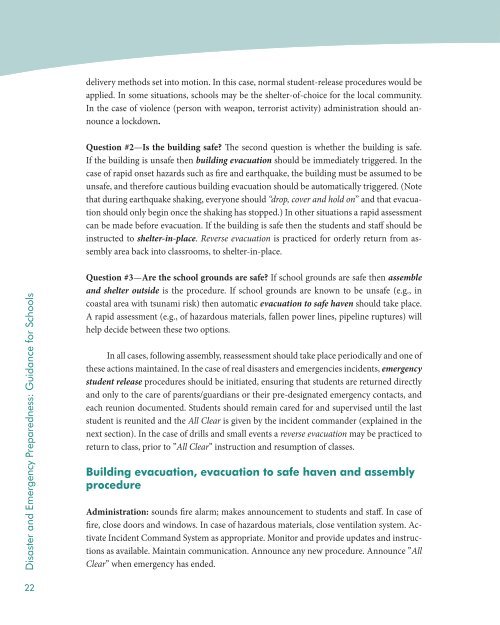Disaster and Emergency Preparedness: Guidance for ... - INEE Toolkit
Disaster and Emergency Preparedness: Guidance for ... - INEE Toolkit
Disaster and Emergency Preparedness: Guidance for ... - INEE Toolkit
You also want an ePaper? Increase the reach of your titles
YUMPU automatically turns print PDFs into web optimized ePapers that Google loves.
delivery methods set into motion. In this case, normal student-release procedures would beapplied. In some situations, schools may be the shelter-of-choice <strong>for</strong> the local community.In the case of violence (person with weapon, terrorist activity) administration should announcea lockdown.Question #2—Is the building safe? The second question is whether the building is safe.If the building is unsafe then building evacuation should be immediately triggered. In thecase of rapid onset hazards such as fire <strong>and</strong> earthquake, the building must be assumed to beunsafe, <strong>and</strong> there<strong>for</strong>e cautious building evacuation should be automatically triggered. (Notethat during earthquake shaking, everyone should “drop, cover <strong>and</strong> hold on” <strong>and</strong> that evacuationshould only begin once the shaking has stopped.) In other situations a rapid assessmentcan be made be<strong>for</strong>e evacuation. If the building is safe then the students <strong>and</strong> staff should beinstructed to shelter-in-place. Reverse evacuation is practiced <strong>for</strong> orderly return from assemblyarea back into classrooms, to shelter-in-place.<strong>Disaster</strong> <strong>and</strong> <strong>Emergency</strong> <strong>Preparedness</strong>: <strong>Guidance</strong> <strong>for</strong> SchoolsQuestion #3—Are the school grounds are safe? If school grounds are safe then assemble<strong>and</strong> shelter outside is the procedure. If school grounds are known to be unsafe (e.g., incoastal area with tsunami risk) then automatic evacuation to safe haven should take place.A rapid assessment (e.g., of hazardous materials, fallen power lines, pipeline ruptures) willhelp decide between these two options.In all cases, following assembly, reassessment should take place periodically <strong>and</strong> one ofthese actions maintained. In the case of real disasters <strong>and</strong> emergencies incidents, emergencystudent release procedures should be initiated, ensuring that students are returned directly<strong>and</strong> only to the care of parents/guardians or their pre-designated emergency contacts, <strong>and</strong>each reunion documented. Students should remain cared <strong>for</strong> <strong>and</strong> supervised until the laststudent is reunited <strong>and</strong> the All Clear is given by the incident comm<strong>and</strong>er (explained in thenext section). In the case of drills <strong>and</strong> small events a reverse evacuation may be practiced toreturn to class, prior to ”All Clear” instruction <strong>and</strong> resumption of classes.Building evacuation, evacuation to safe haven <strong>and</strong> assemblyprocedureAdministration: sounds fire alarm; makes announcement to students <strong>and</strong> staff. In case offire, close doors <strong>and</strong> windows. In case of hazardous materials, close ventilation system. ActivateIncident Comm<strong>and</strong> System as appropriate. Monitor <strong>and</strong> provide updates <strong>and</strong> instructionsas available. Maintain communication. Announce any new procedure. Announce ”AllClear” when emergency has ended.22
















